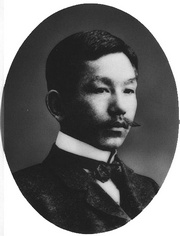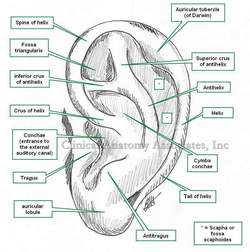
Medical Terminology Daily (MTD) is a blog sponsored by Clinical Anatomy Associates, Inc. as a service to the medical community. We post anatomical, medical or surgical terms, their meaning and usage, as well as biographical notes on anatomists, surgeons, and researchers through the ages. Be warned that some of the images used depict human anatomical specimens.
You are welcome to submit questions and suggestions using our "Contact Us" form. The information on this blog follows the terms on our "Privacy and Security Statement" and cannot be construed as medical guidance or instructions for treatment.
We have 264 guests online

Georg Eduard Von Rindfleisch
(1836 – 1908)
German pathologist and histologist of Bavarian nobility ancestry. Rindfleisch studied medicine in Würzburg, Berlin, and Heidelberg, earning his MD in 1859 with the thesis “De Vasorum Genesi” (on the generation of vessels) under the tutelage of Rudolf Virchow (1821 - 1902). He then continued as a assistant to Virchow in a newly founded institute in Berlin. He then moved to Breslau in 1861 as an assistant to Rudolf Heidenhain (1834–1897), becoming a professor of pathological anatomy. In 1865 he became full professor in Bonn and in 1874 in Würzburg, where a new pathological institute was built according to his design (completed in 1878), where he worked until his retirement in 1906.
He was the first to describe the inflammatory background of multiple sclerosis in 1863, when he noted that demyelinated lesions have in their center small vessels that are surrounded by a leukocyte inflammatory infiltrate.
After extensive investigations, he suspected an infectious origin of tuberculosis - even before Robert Koch's detection of the tuberculosis bacillus in 1892. Rindfleisch 's special achievement is the description of the morphologically conspicuous macrophages in typhoid inflammation. His distinction between myocardial infarction and myocarditis in 1890 is also of lasting importance.
Associated eponyms
"Rindfleisch's folds": Usually a single semilunar fold of the serous surface of the pericardium around the origin of the aorta. Also known as the plica semilunaris aortæ.
"Rindfleisch's cells": Historical (and obsolete) name for eosinophilic leukocytes.
Personal note: G. Rindfleisch’s book “Traité D' Histologie Pathologique” 2nd edition (1873) is now part of my library. This book was translated from German to French by Dr. Frédéric Gross (1844-1927) , Associate Professor of the Medicine Faculty in Nancy, France. The book is dedicated to Dr. Theodore Billroth (1829-1894), an important surgeon whose pioneering work on subtotal gastrectomies paved the way for today’s robotic bariatric surgery. Dr. Miranda.
Sources:
1. "Stedmans Medical Eponyms" Forbis, P.; Bartolucci, SL; 1998 Williams and Wilkins
2. "Rindfleisch, Georg Eduard von (bayerischer Adel?)" Deutsche Biographie
3. "The pathology of multiple sclerosis and its evolution" Lassmann H. (1999) Philos Trans R Soc Lond B Biol Sci. 354 (1390): 1635–40.
4. “Traité D' Histologie Pathologique” G.E.
Rindfleisch 2nd Ed (1873) Ballieres et Fils. Paris, Translated by F Gross
"Clinical Anatomy Associates, Inc., and the contributors of "Medical Terminology Daily" wish to thank all individuals who donate their bodies and tissues for the advancement of education and research”.
Click here for more information
- Details
This article is part of the series "A Moment in History" where we honor those who have contributed to the growth of medical knowledge in the areas of anatomy, medicine, surgery, and medical research.
Sunao Tawara, M.D. (1873 - 1952) Sunao Tawara was born in the prefecture of Ooita, Kyushu, Japan. Adopted by an uncle (and physician), Tawara studied English and German, and went on to the University of Tokyo medical school, where he graduated an MD in 1901.
In 1903 he traveled to Marburg, Germany, where he started working with Dr. Karl Albert Ludwig Aschoff (1866-1942), a noted pathologist. Tawara’s work led him to the discovery of what today we call the “atrioventricular node” (AV node) and the connections of the AV node and the Bundle of His (the right and left bundle branch). His work with Aschoff led to the eponym of “node of Aschoff-Tawara” for the AV node. Tawara’s work also led to the understanding of the function of the Purkinje fibers. Tawara gave the entire system the name “Reitzleitungssytem” or the “conduction system” of the heart.
In 1906 Dr. Tawara published his discoveries in a German-language article entitled “The Conduction System of the Mammalian Heart — An Anatomicopathological Study on the Atrioventricular Bundle and the Purkinje Fibers”. The same year he returned to Japan and in 1908 became Professor of Pathology at the University of Kyushu until his retirement in 1933.
Sources:
1. "Sunao Tawara" Suma, K. Clin Cardiol (1991) 14; 442-443
2. "Sunao Tawara, A Cardiac Pathophysiologist" Loukas, M. et al Clinical Anatomy 21:2–4 (2008)
3. "Sunao Tawara: A Father of Modern Cardiology" Suma, K. J Pacing Clin Electrophysiol (2001) 24:1; 88- 96
- Details
The [circumflex artery] (CFX) is one of the two branches of the left coronary artery, the other one being the left anterior descending artery (LAD), also known as the anterior interventricular artery.
The prefix [circum-] means "around", while the root term [-flex-] means "to bend". This describes quite well the circumflex artery, which "bends around" the obtuse margin of the heart passing from the anterior surface to the posterior surface of the heart.
The circumflex artery lies deep to the epicardium in the subepicardial fatty layer. It gives off several branches, including small left atrial branches and one or two obtuse marginal arteries (OM1 and OM2)that provide blood supply to the left ventricle in its obtuse margin and posterior ventricular region, as well as a portion of the anterior papillary muscle related to the mitral valve.
There can be interesting anatomical variations in the coronary arteries of the heart. For a detail on these anatomical variations, click here. Heart and coronary artery anatomy is one of the many lecture topics presented by CAA, Inc.
Image property of:CAA.Inc.Artist:Victoria G. Ratcliffe
- Details
The prefix [post-] has its origin as a Latin adverb meaning "after". There are two variations in the use of this Latin adverb. The first is in its use as "after" referring to the position of a structure. This use is limited and is the root for the term "posterior". The most common usage is for [post-] to be used in its true meaning of "after" referring to time.
Applications of this prefix include:
- postoperative: after the operation
- postmortem: from the Latin word [mortis] meaning "death". After death
- postpartum: from the Latin word [partum] meaning "birth". After birth
- postprandial: [prandium] is a Latin word meaning "a midday meal". Used to denote "after a meal"
- posthumous: from the Latin word [humus] meaning "ground". Refers to activities performed after burial
- postbellum: after a war
When using pure Latin terms, the word can be used as shown in the listing above, or they can be used as separate entities, such as "post partum", "post mortem", "post bellum", etc. (no hyphens). This leads to interesting facts, such as the pharmacological abbreviation "p.c." which stands for "post cibum"; the meaning of [cibum] is similar to [prandium], so "p.c." means "after a meal"
- Details
The prefix [retro-] has a Latin origin and means "posterior", "backwards", or "behind". The main use of this prefix in human anatomy and surgery is "posterior".
Applications of this prefix include:
- retroesternal: posterior to the sternum, such as the heart or the internal thoracic vessels
- retropharyngeal: posterior to the pharynx, as in the "retropharyngeal space", a potential space found posterior to the pharynx
- retroperitoneal: posterior to the peritoneum, referring to abdominal organs found outside and posterior to the peritoneal sac, such as the aorta and kidneys
- retrogastric: posterior to the stomach, as in the "retrogastric space", an area also known as the "lesser bursa"
- retroversion: a posterior rotation or turn. Usually refers to the posterior rotation of the uterus or a joint
- Details
This article is part of the series "A Moment in History" where we honor those who have contributed to the growth of medical knowledge in the areas of anatomy, medicine, surgery, and medical research.
François Poupart (1661-1709). Physician, zoologist, entomologist, and anatomist, Francois Poupart was born in Le Mans, France. His origins were very humble and he studied Medicine in Paris as a very poor student. He had great interest in entomology, studying the anatomy of insects. Poupart obtained his MD a the University of Reims and was a surgeon at the H?tel (hospital) Dieu. A naturalist, Poupart is known for having written a monograph on the anatomy of the leech.
His life is mostly unknown. Poupart died at the age of 48. His name is eponymically associated with the inguinal ligament, which he described in detail in 1705. Although this structure was originally described by Gabrielle Fallopius, it was Poupart who stated the function of the inguinal ligament as an attachment for the three lateral muscles of the abdominal wall.
*: There is no known image of Francois Poupart that we could find. If you have any source, please let us know through our "Contact Us" form.
Sources:
1. "Two eponymous surgeons: Cowper and Poupart" Ellis, H. Brit J Hosp Med 2009 701:4 225
2. "The Anatomical History of the Leech" Poupart, F. Phil Transact 1697 19:722-726
- Details
The word [pinna] is Latin and means "feather". It also means "wing". The variation [penna] as in the case of [pennate], means "winged". It refer to the external ear, or auricle. It appears that the use of the term [pinna] for ear arises from the ear-like or winged extensions of Viking and medieval helmets.
The ear has three components, the internal, middle, and external ear. The external ear is composed of the external acoustic canal and the pinna. The pinna is composed of fibrocartilage covered with skin, and has several ligaments and small muscles related to it. These muscles are extrinsic (between the pinna and the skull) and intrinsic (within the pinna) All these muscles have limited capabilities in the human.
The pinna receives blood supply from the anterior and posterior auricular arteries, and a small branch of the occipital artery. The nerve supply is by way of the great auricular nerve, the auricular branch of the vagus nerve, the auriculotemporal branch of the mandibular nerve, and the lesser occipital nerve.
The external (lateral) anatomy of the pinna is complicated and very detailed, with potential anatomical variations. Click on the image for a higher detail. The medial aspect of the pinna presents elevations which correspond to the depressions (fossae) on its lateral surface and they are named, eminentia conchae, eminentia triangularis, eminentia scaphoides, etc.
Image property of: CAA, Inc. Artist: Dr. Miranda



![Anterior view of the heart Coronary Arteries. The [*] indicates the left coronary artery](/images/MTD/SmallImages/coronaryarterieslabels_sm.jpg)

